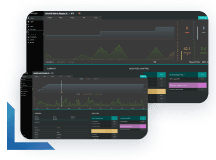
This post explores why stress testing is important, what tools are currently available, and how to succeed when validating your software is under stress.

What is stress testing?
Stress testing is exactly that: ensuring that software continues working under pressure. That means we need to take software to its limits and see how it behaves, not only to identify errors but also to uncover limitations. When you understand the limitations in terms of user load, you can plan accordingly. Then you can determine what resources you need (like the number of servers to use), the specs each server should have, and how fast you need to provision or deprovision resources.
Why stress testing?
Stress testing, a critical aspect of software testing, plays a pivotal role in ensuring the reliability and performance of systems, particularly in high-demand environments such as online ticketing platforms. Let’s continue using the same example as before: an online ticketing system. Suppose that suddenly the website receives far more traffic than expected. Then, similar to the infamous Ticketmaster/Taylor Swift ticketing debacle, the website crashes leaving users unable to purchase tickets. Stress testing helps you to understand how many users you can serve with the resources you have. Further, it can help you identify which resources you lack if you need to serve more customers.
With stress testing, organizations can proactively address system vulnerabilities, optimize resource allocation, and enhance overall user experience, ensuring seamless operations even under extreme load conditions. By conducting stress testing regularly and systematically, companies can build robust and scalable systems that can withstand unexpected spikes in traffic, minimizing downtime and maximizing customer satisfaction.
‘’To get started with stress testing, you need to ensure that you can put your software under enough stress to evaluate its performance and reliability.’’
Steps for a successful stress test
There are some key steps you need to consider to successfully run stress tests.
STEP 1
The initial step involves determining the suitable environment for conducting stress tests. Using the same infrastructure as your software is not viable; it must be independent and scalable to accurately simulate real-world scenarios. Additionally, the testing tool should generate the anticipated load to ensure meaningful stress testing. Managed solutions like Tricentis NeoLoad can facilitate this process efficiently. Once this aspect is addressed, it’s crucial to delve into strategic considerations.
STEP 2
The second step involves designing stress tests that align with the specific requirements and usage patterns of your software. To achieve this:
- Identify usage scenarios: Begin by identifying the expected usage scenarios for your software. Consider factors such as the number of concurrent users, transaction volumes, and expected traffic patterns throughout the day.
- Analyze performance requirements: Assess the performance requirements of your software, including response times, throughput, and resource utilization thresholds. Prioritize areas that are critical for maintaining optimal user experience.
- Tailor test configuration: Based on the identified usage scenarios and performance requirements, tailor the test configuration to simulate realistic load conditions. Adjust parameters such as the number of virtual users, transaction mix, and duration of the test accordingly.
- Consider peak load scenarios: Anticipate potential peak load scenarios and design stress tests to evaluate the software’s performance under such conditions. This may involve simulating sudden spikes in traffic or periods of sustained high load.
- Adapt test environment: Ensure that the test environment accurately reflects the production environment in terms of hardware, network configuration, and software stack. This enables realistic simulation of user interactions and system behavior.
- Implement scalability testing: If scalability is a key consideration, incorporate scalability testing into your stress testing strategy. Evaluate how the software scales in response to increasing load levels and assess its ability to handle growing user demand.
- Define test metrics: Define clear metrics and performance indicators to measure the effectiveness of the stress tests. Monitor metrics such as response times, error rates, and system resource utilization to identify performance bottlenecks and areas for improvement.
- Iterative testing approach: Adopt an iterative approach to stress testing, where test configurations and scenarios are refined based on insights gained from initial test runs. Continuously optimize the test strategy to address emerging requirements and evolving user expectations.
By designing stress tests tailored to the specific requirements and usage patterns of your software, you can effectively assess its performance under realistic conditions and identify potential areas for optimization.
STEP 3
Consider that stress tests are not a one-time-only event. It’s important that you stress test your software continuously to find out quickly when performance is degrading. The third step involves establishing a set of meaningful metrics that serve as indicators of your software’s performance. These metrics provide valuable insights into whether your software is functioning as expected. To achieve this, consider the following:
- Response time: Measure the time taken for the system to respond to user requests, including page load times and transaction processing times. For instance, if the response time exceeds a certain threshold under heavy load, it may indicate performance degradation.
- Throughput: Assess the rate at which the system can process requests or transactions, indicating its capacity to handle concurrent user interactions. For example, if the throughput decreases significantly as the number of concurrent users increases, it suggests potential scalability issues.
- Error rate: Monitor the frequency of errors or failures encountered by users, helping identify potential issues affecting system reliability and user experience. For instance, a sudden increase in error rates during stress testing may indicate instability or insufficient error handling mechanisms.
- Resource utilization: Track the utilization of system resources such as CPU, memory, and network bandwidth during load testing, ensuring optimal resource allocation and performance. If resource utilization reaches critical levels under load, it may lead to performance degradation or system failures.
- Latency: Evaluate the delay experienced by users when interacting with the software, identifying potential bottlenecks or performance degradation under high load conditions. For example, if latency spikes occur during peak usage periods, it may indicate congestion or inefficient processing.
By establishing these metrics, you can effectively gauge the performance of your software and identify areas that require optimization. For example, if your software exhibits high latencies under concurrent user loads, it indicates the need for tuning to ensure satisfactory performance for larger user volumes. Conducting tests to determine the threshold at which latency increases to an unacceptable level provides valuable insights for optimizing software performance and scalability.
‘’Be international on taking your software to an extreme to understand how it behaves and what you need to tune’’
Stress testing challenges and solutions
To get started with stress testing, you need to make sure you can put your software under enough stress to simulate not just the existing load your software typically gets, but to make sure it’s prepared to scale. It’s hard to simulate production traffic. You might also need to configure your tests to simulate different scenarios running at the same time. And lastly, you need to have some sort of visibility to know how your software behaves when it’s under stress.
To address these challenges, there are some tools that help you automate the different techniques I talked about before. There are some particularly important aspects of a stress testing tool you need to consider before you choose. Tools should be easy to install, configure, and use. They should also easily escalate to simulate high user activity and be flexible enough to test diverse types of applications and protocols.
It’s also important that these tools can integrate with others you might already have, like Jenkins, to run stress tests every time you release a new software version (and not just run these tests every now and then). Lastly, stress testing tools should provide meaningful reports after running tests, as this will help you understand the experience from the user perspective. For example, the error rate these tools show might be different from the error rate your application monitors give, simply because at some point requests stop coming to your software.
Stress testing tools overview
- JMeter: An open-source tool developed in Java for simulating user traffic on web applications or servers. It’s widely used and offers flexibility for stress testing various components of web applications.
- BlazeMeter: A commercial version of JMeter with additional features and support. It provides a scalable platform for load testing and performance monitoring.
- Gatling: Another open-source tool written in Scala, primarily used for testing web applications or servers. It emphasizes high performance and offers advanced scripting capabilities for simulating complex user scenarios.
- NeoLoad: A managed solution for stress testing that supports testing across modern and legacy technologies. It allows users to run performance tests, test in multiple browser versions, and conduct continuous testing to ensure application reliability and scalability.
With NeoLoad performance testing tool, stress testers create and execute tests with real-time diagnostics for fast and recurrent testing. NeoLoad also supports the creation of highly advanced tests for all web and mobile technologies.
The ability to compare stress test results allows you to validate tuning and optimization on your application. Load and traffic are generated from your lab or dynamically provisioned machines all over the world, depending on expected production visitor locations. Real-time diagnostics allow you to identify and resolve bottlenecks during the load testing session. Performance metrics and monitoring counters are collected during the performance test and automatically validated against your SLAs.
The results: Analysis time is dramatically decreased compared to other load testing tools.
Benefits of web stress testing with NeoLoad
- Run a web application realistically by simulating many clients simultaneously hitting your site
- Supports stress testing of all standard and rich applications (RIA) for desktop and mobile devices
- Works on any HTTP(s) URL
- Conducts stress testing for CRM, ERP and Business Intelligence – type applications
- Monitors all major servers available on the market
- Enterprise-class: Efficient and infinitely scalable, infrastructure monitoring capability, APM tools integration
- Easy-to-use stress testing tool: Scriptless test creation, GUI-driven design, automated parameterization
- Quick time-to-value: Helps you create realistic tests in minutes! Automated report generator
- Cost-effective: Low-cost licensing and maintenance, flexible licensing options
- Fully integrated on-demand load generation from the Cloud
- Avoid denial of service attacks on your web servers
Final thoughts
Stress tests are a set of tests that are typically considered when software performance is poor, but you should consider performance as a feature. Be intentional about taking your software to an extreme to understand how it behaves and what you need to tune. Even though there are several tools on the market, consider using one that allows you to spend more time improving your software than configuring stress tests properly.
Before you get started with stress testing, spend time understanding what good looks like for your software and be precise. It’s very vague to say that you want to have fast software. It’s better to say you want software that can be used to serve thousands of users concurrently.
This post was written by David Snatch. David is a cloud architect focused on implementing secure continuous delivery pipelines using Terraform, Kubernetes, and any other awesome tech that helps customers deliver results.
